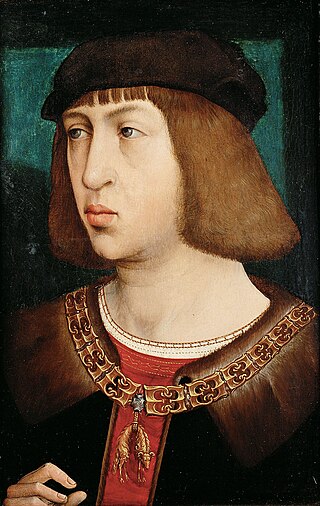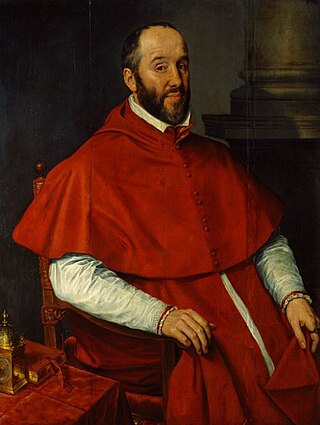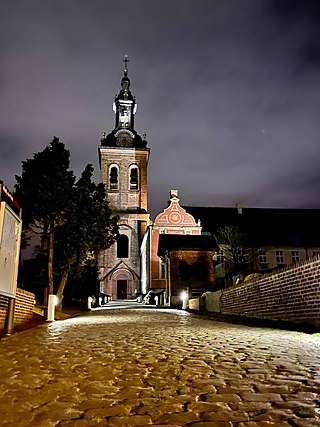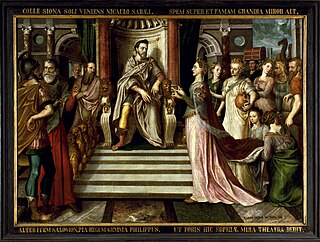
Hubert Languet was a French diplomat and reformer. The leading idea of his diplomacy was that of religious and civil liberty for the protection and expansion of Protestantism. He did everything in his power to advance the union of the Protestant churches.

Charles V was Holy Roman Emperor and Archduke of Austria from 1519 to 1556, King of Spain from 1516 to 1556, and Lord of the Netherlands as titular Duke of Burgundy from 1506 to 1555. He was heir to and then head of the rising House of Habsburg. His dominions in Europe included the Holy Roman Empire, extending from Germany to northern Italy with rule over the Austrian hereditary lands and Burgundian Low Countries, and Spain with its possessions of the southern Italian kingdoms of Naples, Sicily and Sardinia. In the Americas, he oversaw the continuation of Spanish colonization and a short-lived German colonization. The personal union of the European and American territories he ruled was the first collection of realms labelled "the empire on which the sun never sets".

William the Silent or William the Taciturn, more commonly known in the Netherlands as William of Orange, was the leader of the Dutch revolt against the Spanish Habsburgs that set off the Eighty Years' War (1568–1648) and resulted in the formal independence of the United Provinces in 1648. Born into the House of Nassau, he became Prince of Orange in 1544 and is thereby the founder of the Orange-Nassau branch and the ancestor of the monarchy of the Netherlands. In the Netherlands, he is also known as Father of the Fatherland.

Philip the Handsome, also called the Fair, was ruler of the Burgundian Netherlands and titular Duke of Burgundy from 1482 to 1506, as well as the first Habsburg King of Castile for a brief time in 1506.

Mary of Burgundy, nicknamed the Rich, was a member of the House of Valois-Burgundy who ruled a collection of states that included the duchies of Limburg, Brabant, Luxembourg, the counties of Namur, Holland, Hainaut and other territories, from 1477 until her death in 1482.

Antoine Perrenot de Granvelle, Comte de La Baume Saint Amour, was a Burgundian statesman, made a cardinal, who followed his father as a leading minister of the Spanish Habsburgs, and was one of the most influential European politicians during the time which immediately followed the appearance of Protestantism in Europe; "the dominating Imperial statesman of the whole century". He was also a notable art collector, the "greatest private collector of his time, the friend and patron of Titian and Leoni and many other artists".

Archduchess Margaret of Austria was Governor of the Habsburg Netherlands from 1507 to 1515 and again from 1519 to 1530. She was the first of many female regents in the Netherlands.

The Council of State is a constitutionally established advisory body in the Netherlands to the government and States General that officially consists of members of the royal family and Crown-appointed members generally having political, commercial, diplomatic or military experience. It was founded in 1531, making it one of the world's oldest still-functioning state organisations.

René de Birague was an Italian then French noble, lieutenant-general, chancellor and cardinal during the latter Italian Wars and the French Wars of Religion. Born to a prominent Milanese family in 1506, his family sided with the French, and as such when Milan was occupied by Emperor Charles V they were forced to flee to French controlled Piedmont. Declared a criminal in 1536, his Milanese estates would be seized. Birague entered French service in the 1540s, being elevated to premier président of the Parlement of Turin, which in combination with his service under the French governor Marshal Brissac from 1550, afforded him immense administrative power in the French occupied territories. In 1562 with the French withdrawal from the Piedmont, he departed his post in the Parlement, however the following year would see him elevated in one of the remaining French held towns, as leader of the Supreme Council of Pignerol.

Philippe de Croÿ, 3rd Duke of Aarschot, 4th Prince of Chimay, Count of Porcean, was Stadtholder of Flanders, and inherited the estates of the ancient and wealthy family of Croÿ. Becoming a soldier, he was made a Knight of the Order of the Golden Fleece by Philip II, king of Spain, and was afterwards employed in diplomatic work.

Elisabeth of Austria was Queen of France from 1570 to 1574 as the wife of King Charles IX. A member of the House of Habsburg, she was the daughter of Maximilian II, Holy Roman Emperor, and Maria of Spain.

Jean II Carondelet, was a Burgundian cleric, politician, jurist and one of the most important advisors to Charles V, Holy Roman Emperor. He was a patron of the Dutch philosopher Erasmus and a brother of the Habsburg diplomat Ferry Carondelet.

François de Tournon was a French Augustinian friar, an archbishop, diplomat, courtier, and cardinal. From 1536 he was also a military supply officer of French forces operating in Provence, Savoy and Piedmont. In the same year he founded the Collège de Tournon. For a period he was effectively France's foreign minister. He was a prominent leader in the fight against Lutheranism and Calvinism, especially at the French Royal Court, and what he perceived as the growing Huguenot menace to both doctrinal orthodoxy and the social order. He took a prominent role in the Estates General of 1560, the Colloquy of Poissy and the Colloquy of Saint-Germain in 1562. He participated in the papal conclaves of 1534, 1549, and 1559.

Park Abbey is a Premonstratensian abbey in Belgium, at Heverlee just south of Leuven, in Flemish Brabant.
Philippe René Nivelon Louis de Sainte-Aldegonde, Lord of Noircarmes was a statesman and soldier from the Habsburg Netherlands in the service of Charles V, Holy Roman Emperor, and Philip II of Spain. He gained notoriety during the suppression of Calvinist insurrections, especially at Valenciennes in 1566-7, and as a member of the Council of Troubles at the start of the Eighty Years' War. He was stadtholder of Hainaut from 1566, and of Holland, Zeeland and Utrecht from 1573 until his death.

The Old University of Leuven is the name historians give to the university, or studium generale, founded in Leuven, Brabant, in 1425. The university was closed in 1797, a week after the cession to the French Republic of the Austrian Netherlands and the principality of Liège by the Treaty of Campo Formio.

Charles Joseph Mathieu Lambrechts was a Belgian-born lawyer, rector magnificus of the University of Louvain, who became Minister of Justice of the French Republic, during the Directoire. Later he was a deputy from 1819 to 1824.

The Privy Council or Secret Council was one of the three "collateral councils" that together formed the highest government institutions of the Habsburg Netherlands. Based in Brussels, it was particularly charged with legal and administrative questions.

The Queen of Sheba visits King Solomon, also known as Solomon and the Queen of Sheba, is a painting by the Flemish painter Lucas de Heere. Dated from 1559, it features a contemporary interpretation of the well-known Biblical story of the Queen of Sheba's state visit to King Solomon. Lettered within image, in lower right: "Lvcas Derys inv. fecit 1559".

The Burgundian State is a concept coined by historians to describe the vast complex of territories that is also referred to as Valois Burgundy.





















